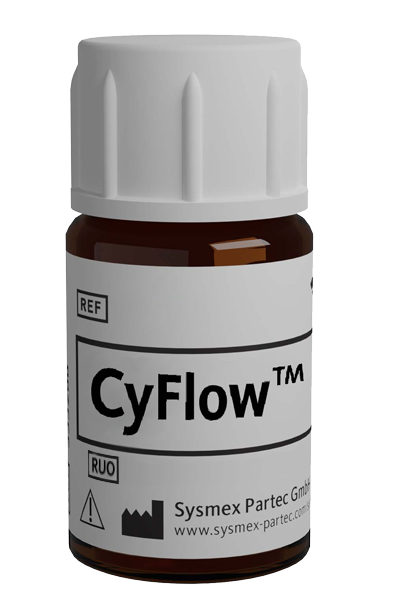CyFlow™ CD3 PerCP-Cy5.5

| Alternative Name: | Leu4, T3 |
| Antibody: | Yes |
| Antigen: | CD3 |
| Application: | Flow cytometry |
| Clonality: | monoclonal |
| Clone: | 145-2C11 |
| Emission Maximum: | 695 nm |
| Excitation Maximum: | 482 nm |
| Field of Interest: | Immunophenotyping, MHC |
| Format/Fluorochrome: | PerCP-Cy5.5 |
| Isotype: | IgG |
| Laser: | Blue , Green |
| Regulatory Status: | RUO |
| Source Species: | Hamster |
| Target Species: | Mouse |
| Product number: | BJ628650 |
For Research Use Only
| Concentration Unit | mg/mL |
| Concentration | 0,5 |
| Quantity | 0.1 mg |
| Volume | 0.2 mL |
| Immunogen | Mouse BM10-37 cytotoxic T lymphocytes |
| Background Information | CD3 complex is crucial in transducing antigen-recognition signals into the cytoplasm of T cells and in regulating the cell surface expression of the TCR complex. T cell activation through the antigen receptor (TCR) involves the cytoplasmic tails of the CD3 subunits CD3γ, CD3 δ, CD3ε and CD3ζ. These CD3 subunits are structurally related members of the immunoglobulins superfamily encoded by closely linked genes on human chromosome 11. The CD3 components have long cytoplasmic tails that associate with cytoplasmic signal transduction molecules. This association is mediated at least in part by a double tyrosine-based motif present in a single copy in the CD3 subunits. CD3 may play a role in TCR-induced growth arrest, cell survival and proliferation. |
| Usage | The reagent is designed for Flow Cytometry analysis. Working concentrations should be determined by the investigator. |
| Storage Buffer | The reagent is provided in phosphate buffered saline (PBS) solution, pH ≈7.4, containing 0.09% (w/v) sodium azide. |
| Storage | Avoid prolonged exposure to light. Store in the dark at 2-8°C. Do not freeze. |
| Stability | Do not use after expiration date stamped on vial label. |
| Leo O, Foo M, Sachs DH, Samelson LE, Bluestone JA: Identification of a monoclonal antibody specific for a murine T3 polypeptide. Proc Natl Acad Sci USA. 1987 Mar; 84(5):1374‑8. < PMID: 2950524 > | Samelson LE, O'Shea JJ, Luong H, Ross P, Urdahl KB, Klausner RD, Bluestone J: T cell antigen receptor phosphorylation induced by an anti‑receptor antibody. J Immunol. 1987 Oct 15; 139(8):2708‑14. < PMID: 2443570 > | Payer E, Elbe A, Stingl G: Circulating CD3+/T cell receptor V gamma 3+ fetal murine thymocytes home to the skin and give rise to proliferating dendritic epidermal T cells. J Immunol. 1991 Apr 15; 146(8):2536‑43. < PMID: 1826696 > | Jacobs H, Vandeputte D, Tolkamp L, de Vries E, Borst J, Berns A: CD3 components at the surface of pro‑T cells can mediate pre‑T cell development in vivo. Eur J Immunol. 1994 Apr; 24(4):934‑9. < PMID: 8149963 > | Salvadori S, Gansbacher B, Pizzimenti AM, Zier KS: Abnormal signal transduction by T cells of mice with parental tumors is not seen in mice bearing IL‑2‑secreting tumors. J Immunol. 1994 Dec 1; 153(11):5176‑82. < PMID: 7963575 > | Vossen AC, Tibbe GJ, Kroos MJ, van de Winkel JG, Benner R, Savelkoul HF: Fc receptor binding of anti‑CD3 monoclonal antibodies is not essential for immunosuppression, but triggers cytokine‑related side effects. Eur J Immunol. 1995 Jun; 25(6):1492‑6. < PMID: 7614975 > | Henrickson M, Reid J, Bellet JS, Sawchuk SS, Hirsch R: Comparison of in vivo efficacy and mechanism of action of antimurine monoclonal antibodies directed against TCR alpha beta (H57‑597) and CD3 (145‑2C11). Transplantation. 1995 Oct 27; 60(8):828‑35. < PMID: 7482743 > | Kinnaert P, Pradier O, Bournonville B, Habrant C, Goldman M, Van Geertruyden N: Role of CD18‑dependent and CD18‑independent mechanisms in the increased leukocyte adhesiveness and in the variations of circulating white blood cell populations induced by anti‑CD3 monoclonal antibodies. Transpl Int. 1996; 9(4):386‑91. < PMID: 8819275 > | Kearse KP: Calnexin associates with monomeric and oligomeric (disulfide‑linked) CD3delta proteins in murine T lymphocytes. J Biol Chem. 1998 Jun 5; 273(23):14152‑7. < PMID: 9603915 > | Han WR, Murray-Segal LJ, Gershenzon A, Zhang JG, Hodder AN, Pietersz GA, Mottram PL: Idarubicin‑145‑2C11‑F(ab')2 promotes peripheral tolerance and reduces chronic vascular disease in mouse cardiac allografts. Transpl Immunol. 1999 Dec; 7(4):207‑13. < PMID: 10638833 > | Tilley SL, Jaradat M, Stapleton C, Dixon D, Hua X, Erikson CJ, McCaskill JG, Chason KD, Liao G, Jania L, Koller BH, Jetten AM: Retinoid‑related orphan receptor gamma controls immunoglobulin production and Th1/Th2 cytokine balance in the adaptive immune response to allergen. J Immunol. 2007 Mar 1; 178(5):3208‑18. < PMID: 17312169 >
